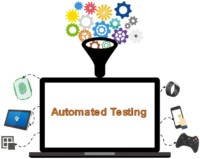Every quality assurance expert is aware of automated software testing, its benefits, and associated challenges. However, for those in small companies or with a simple or single product to manage, manual functional testing and regression testing may be the limits of their expertise. At some point, the need for automation may appear on the horizon or management comes to the rescue and says, “we want 100% test automation, we need to reduce our testing time and resources”. If management is mandating automation with the percentage of automation goals, STOP HERE, and watch this video on the Top Seven Test Automation Mistakes to Avoid.
Understanding Key Benefits
With pressure to automate, we encourage you to think through your goals for automation and what will make your boss satisfied with the automation effort. Without understanding what your objectives are, how will you know you’ve been successful. For this, it’s helpful to list out and understand the benefits of test automation in determining your goals.
- Save time: Generally, automation increases the speed of the testing process and shortens the testing lifecycle.
- You can run scripts in the night, effectively giving you a day shift and night shift.
- You can run scripts on multiple machines-multiple platforms simultaneously.
- Scripts run faster than a manual tester.
- Utilize manpower more effectively: Apply your skills and time where they are needed most.
- Manual testing can be used for new feature validation while automation can be used for regression.
- Most functional and regression testing can execute unattended.
- Focus efforts where you didn’t have time for before, such as performance and security.
- Increase coverage: You can test how the software reacts under repeated execution of the same operations.
- Do the same tests on multiple Configurations and more configurations.
- Regression suites can cover every feature in your application which may be difficult to accomplish manually depending on your application’s size.
Different versions can reuse the same automation code with minor modifications.
Understanding Key Challenges
Next, it’s a good idea to understand what challenges you’ve got in store not only so that you know what questions to ask when automation vendors come courting you, in formulating realistic expectations when you solidify your automation objectives.
- Automation tool selection: Not all tools are alike, and not all tools will work with your software. Depending on your software’s architecture and platform, not all tools are suited to work. Perhaps any tool could work, but some are easier than others, and it may not be possible to achieve all your objectives.
- Unstable user interface: If the user interfaces changes frequently, developing scripts with a good architecture is difficult and the scripts are hard to maintain.
- Custom controls: If programmers used custom controls in the application, for example, instead of standard windows controls (dropdown list, input box, etc.), it’s very difficult to automate testing because any tool used will have problems recognizing the customized controls. Without recognition, invoking their functions and special functionalities will be difficult to test.
- Environment and software configuration: If setting up the targeted objective test system needs manual intervention and configuration; this makes the product under test difficult to recover from an error. This causes the automated test execution to need to be manually monitored which defeats part of the purpose of automation.
Understanding Key Trends
One of the latest trends in overcoming these challenges is applying machine learning and artificial intelligence to test automation. For example, with unstable user interfaces, artificial intelligence efforts enable the scripts to heal themselves and find the appropriate objects. They can even learn what buttons look like and find a similar button. However, even if scripts can heal themselves, a real human still needs to check that they were healed or fixed correctly.
Other places where machine learning and artificial intelligence are being used is determining the best test areas to focus automation efforts and the most fruitful or effective areas to execute manual testing. All of these efforts are in various stages of maturity. Similar to a decade ago when vendors were touting their codeless automation tools, be aware of the glitz and promises.
XBOSoft Test Automation Assessment
We’ve enumerated a simple summary above, but as you can imagine, we’ve only touched the surface. If you’re feeling inundated with information and conflicting goals of trying to reduce regression time and costs, yet realizing that automation won’t come free and will take significant time and effort, you’re not alone.
XBOSoft’s test automation assessment examines your software combined with your test automation objectives to develop a test automation strategy and action plan. We assess which parts are suitable for automated testing and which parts are not while recommending the most appropriate set of tools and how to design and implement automation within the framework of your organization and its QA processes. Here’s what you get:
Advantages
- A customized software test automation strategy designed specifically for your product outlining which parts of your software are suitable tor automation and which are best suited to manual testing combined with what tools are most appropriate.
- An understanding of what tool to choose and why for you, and your organization.
- A phased assessment methodology with documentation provided after each stage with a test automation framework and architecture that will carry you for the long term.
- A ‘teach you how to fish’ approach through demonstration and practicality where you end up with a maintainable automation program that will enable you to increase software quality over the long run.


Leave A Comment